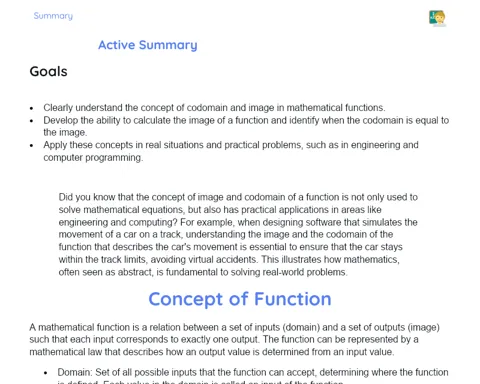Introduction
Point, Plane, and Line: The School of Space!
- Imagine that space is our math classroom.
- Points are the students, each with their unique location in the room.
- Planes are the desks, with their extension in two dimensions.
- Lines are the connections that link each student to their location in the room.
So, let's start this amazing journey through Euclidean Geometry, the heart of Mathematics!
Relevance of the Theme
Point, Plane, and Line are the fundamental building blocks of geometry and play a crucial role in almost every topic within this discipline. They form the basis for understanding more advanced concepts, such as solids, angles, and intersections, and are essential for the practical application of mathematics in fields like physics, engineering, and architecture. Furthermore, understanding these concepts enhances spatial visualization skills, a key component of mathematical thinking. Therefore, investing time in mastering these structures is a vital first step on the journey to becoming a skilled mathematician.
Theoretical Development
Components
-
Point:
- It is a dimensionless entity.
- Identified by its unique location in a coordinate system, usually denoted by a capital letter.
- Points can be considered as the 'raw material' of geometry, as they are used to define all other elements.
-
Plane:
- It is a two-dimensional surface without edges, extending infinitely in all directions.
- Can be defined by three non-collinear points or by a line and a point outside the line.
- The word 'plane' comes from the Greek 'planos', which means 'spread out flat'.
-
Line:
- It is an infinite line that extends infinitely in both directions.
- Formed by infinite points.
- Any two lines in a plane either intersect at a single point or are parallel.
Key Terms
-
Euclidean Space: A geometric space defined by a set of points, where each point has a unique location that can be determined through coordinates.
-
Euclidean Geometry: A system of classical geometry based on Euclid's postulates, which introduced the concepts of points, planes, and lines.
-
Collinearity: Term used to describe points that are all on the same straight line.
Examples and Cases
-
Point:
- Suppose a map of a city where latitudes and longitudes are indicated - each location in the city can be represented by a point on the map.
-
Plane:
- Consider a soccer field - its surface is a plane.
- To describe a player's position, we can use a sideline and a goal line as reference.
-
Line:
- In the same soccer field analogy, the marking lines are lines.
- A player's pass, for example, can be represented by a line connecting the player's initial position to the final position of the ball.
Detailed Summary
Key Points
-
Points, points, points! They are the essence of Geometry! We can imagine them as small individuals, each with a unique location, forming the basis of all other geometric elements.
-
Two-dimensional planes! They are like infinite extensions of tables, without edges, going in all directions! They can be defined by three non-collinear points or by a line and a point outside the line.
-
Infinite lines! We say lines are infinite because they have no beginning or end. They are like the lines that connect each student to their location in the room. Any two different lines always intersect at a single point or are parallel.
Conclusions
-
Space is everything! In the world of geometry, everything exists in space. Point, line, plane - all are spatial distinctions that help us understand the world we live in (mathematically speaking, of course!).
-
Simplicity is key! Despite being fundamental concepts, do not underestimate the power of points, planes, and lines. With them, we can understand, describe, and visualize complex phenomena in surprisingly simple ways.
-
Geometry is life! If they are important for mathematics, they are important for life! The ability to understand and manipulate points, planes, and lines is essential for many disciplines and professions, not just for mathematicians and engineers.
Exercises
-
Locating points: Given a Cartesian coordinate system, locate the points A(-3,2), B(4,-1), and C(0,0).
-
Defining planes: Draw a triangle on paper. Using a ruler, try to define the plane that contains this triangle based on its definition. Remember, a plane is a two-dimensional surface without edges!
-
Invent a line!: Look around you. Choose two points anywhere in the room and try to draw the line that connects these two points. This should help reinforce the understanding that a line is a line that extends infinitely in both directions.



